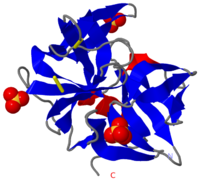Chymotrypsin
From Proteopedia
(Difference between revisions)
| Line 19: | Line 19: | ||
This view shows the <scene name='38/387136/Bovine_chymotrypsin_active_sit/3'>carbonyl group of the inhibitor</scene> in CPK colors. The triflouromethyl group is bound to the carbonyl carbon via the yellow bond. In a peptide substrate, the triflouromethyl group would be replaced by the first amino acid residue of the rest of the peptide chain, and the yellow bond would be the bond that is cleaved. The carbonyl carbon of the inhibitor is 1.52 Å away from the side chain oxygen of serine 195, and this indicates they are covalently bound (bond indicated by dotted line). Thus, this structure is similar to the '''tetrahedral intermediate''' that is formed during the cleavage reaction. The negative charge that develops on the carbonyl oxygen of the substrate is stabilized by hydrogen bonds to the backbone nitrogens of Ser 195 and Gly 193, shown in blue spacefill. The hydrogen atoms involved in these hydrogen bonds are not shown. | This view shows the <scene name='38/387136/Bovine_chymotrypsin_active_sit/3'>carbonyl group of the inhibitor</scene> in CPK colors. The triflouromethyl group is bound to the carbonyl carbon via the yellow bond. In a peptide substrate, the triflouromethyl group would be replaced by the first amino acid residue of the rest of the peptide chain, and the yellow bond would be the bond that is cleaved. The carbonyl carbon of the inhibitor is 1.52 Å away from the side chain oxygen of serine 195, and this indicates they are covalently bound (bond indicated by dotted line). Thus, this structure is similar to the '''tetrahedral intermediate''' that is formed during the cleavage reaction. The negative charge that develops on the carbonyl oxygen of the substrate is stabilized by hydrogen bonds to the backbone nitrogens of Ser 195 and Gly 193, shown in blue spacefill. The hydrogen atoms involved in these hydrogen bonds are not shown. | ||
| + | |||
| + | == 3D Structures of Chymotrypsin == | ||
| + | [[Chymotrypsin 3D structures]] | ||
| + | |||
</StructureSection> | </StructureSection> | ||
== 3D Structures of Chymotrypsin == | == 3D Structures of Chymotrypsin == | ||
| Line 29: | Line 33: | ||
* Native α-chymotrypsin | * Native α-chymotrypsin | ||
| - | **[[1yph]] – | + | **[[1yph]], [[4cha]], [[5cha]] – bChy chain A - bovine<br /> |
| - | **[[ | + | **[[6di8]] – bChy chain A+B+C<br /> |
| - | **[[1kdq]] – | + | **[[1kdq]] – rChy chain B (mutant) - rat<br /> |
**[[2ea3]] – Chy – ''Cellulomonas bogoriensis''<br /> | **[[2ea3]] – Chy – ''Cellulomonas bogoriensis''<br /> | ||
* α-chymotrypsin + polypeptide inhibitors | * α-chymotrypsin + polypeptide inhibitors | ||
| + | **[[4h4f]] – hChyC +Elgin C - human<br /> | ||
**[[1cbw]], [[1mtn]] - bChy+BPTI <br /> | **[[1cbw]], [[1mtn]] - bChy+BPTI <br /> | ||
**[[1t7c]], [[1t8l]], [[1t8m]], [[1t8n]], [[1t8o]] – bChyA+P1 BPTI variants<br /> | **[[1t7c]], [[1t8l]], [[1t8m]], [[1t8n]], [[1t8o]] – bChyA+P1 BPTI variants<br /> | ||
| Line 47: | Line 52: | ||
**[[1acb]] – bChy+Elgin C <br /> | **[[1acb]] – bChy+Elgin C <br /> | ||
**[[1cho]], [[1hja]] – bChyA+turkey ovomucoid third domain <br /> | **[[1cho]], [[1hja]] – bChyA+turkey ovomucoid third domain <br /> | ||
| - | **[[4h4f]] – hChyC +Elgin C - human<br /> | ||
* α-chymotrypsin + inhibitors | * α-chymotrypsin + inhibitors | ||
Revision as of 08:16, 13 May 2019
| |||||||||||
3D Structures of Chymotrypsin
Updated on 13-May-2019
The Chy precursor is the inactive chymotrypsinogen (Chygen) which gets cleaved 3 times by trypsin and chymotrypsin losing a 4 amino acid long peptide to become the active Chy. γ-Chy is a covalent acyl adduct of α-Chy. δ-Chy results when Chygen is cleaved only twice.
References
- ↑ Appel W. Chymotrypsin: molecular and catalytic properties. Clin Biochem. 1986 Dec;19(6):317-22. PMID:3555886
Further reading
You can learn more about chymotrypsin structure, function and regulation in this publicly available chapter of the Biochemistry textbook by Berg, Tymoczka and Stryer.
Proteopedia Page Contributors and Editors (what is this?)
Michal Harel, Karsten Theis, Alice Harmon, Alexander Berchansky


